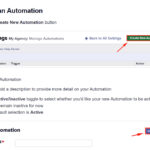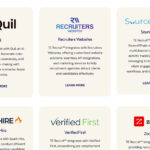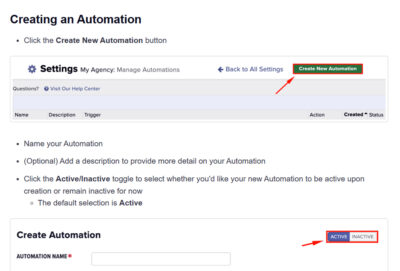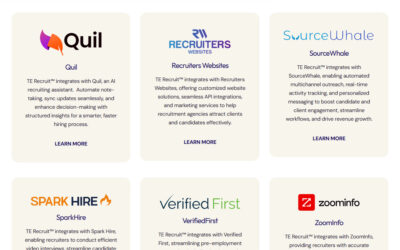Artificial intelligence (AI) is no longer a futuristic concept; it’s a powerful tool already being leveraged across numerous industries, including recruitment. As AI continues to permeate the recruitment landscape, it’s transforming how companies attract, evaluate, and hire talent. The reason is simple: AI brings unparalleled efficiency, precision, and scalability, reshaping traditional practices by eliminating bias, enhancing decision-making, and quickly identifying top talent. As the capabilities of AI expand, the recruitment landscape is being altered in ways that may very well be irreversible.
In this article from Top Echelon Recruiting Software, we’ll take a closer look at how AI is revolutionizing the future of the recruitment process and why it’s here to stay.
Enhanced Job Posting Performance
Traditionally, recruiters have relied on intuition and manual tracking to measure the effectiveness of job postings across various platforms, but this approach has always been limited by human error and inefficiency. AI technology is changing this paradigm by providing precise analytics on the performance of job ads, revealing which postings generate the most engagement, and on which platforms.
By leveraging AI, recruiters can now assess in real-time which job boards yield the best results, enabling them to target their ads more effectively. For example, AI algorithms can analyze past performance data to predict the likelihood of a job posting’s success on different platforms. This helps recruiters make informed decisions about where to allocate their budget, optimizing spend and improving return on investment. The use of AI also enables dynamic adjustments, where job postings can be modified based on live data, ensuring that ads remain relevant and appealing to the desired audience.
Intelligent Job Description Optimization
Crafting job descriptions is more of an art than a science, often involving trial and error to find the perfect balance between attracting qualified candidates and discouraging unqualified applicants. AI is turning this into a more strategic process by analyzing existing job descriptions and providing recommendations for improvement. AI-driven platforms can identify language that may inadvertently exclude qualified candidates or fail to resonate with the intended audience.
AI tools analyze millions of job descriptions and candidate profiles to recommend language that is more inclusive and aligned with the organization’s diversity goals. They suggest terms and phrases that are proven to attract a diverse range of candidates, minimizing unconscious biases that can creep into job descriptions. This not only broadens the talent pool but also enhances the organization’s brand by demonstrating a commitment to inclusivity and diversity.
Maximizing the Existing Talent Pool
Organizations often overlook one of their most valuable resources in recruitment—their existing talent pool. AI can tap into this often underutilized reservoir by using sophisticated algorithms to match current employees or past applicants with new job openings. For example, an AI-driven Applicant Tracking System (ATS) can scan an organization’s existing database and identify candidates who have previously applied or expressed interest in similar roles.
This capability significantly reduces time spent sourcing candidates externally, accelerates the hiring process, and lowers recruitment costs. Additionally, by leveraging the data already in the system, recruiters can re-engage with previously interested candidates, nurturing these relationships and potentially filling positions more quickly. This approach is especially beneficial for high-volume roles or niche positions that are challenging to fill.
Engaging Passive Job Seekers
Identifying and engaging passive job seekers—those who are not actively looking for new opportunities but could be open to change—is one of the biggest challenges in recruitment. AI technology addresses this challenge by analyzing data from various sources, such as social media profiles, professional networks, and public records, to identify potential candidates who fit the desired profile.
AI not only identifies these passive candidates but also uses predictive analytics to determine when they might be open to new opportunities. For instance, it can analyze patterns such as the average tenure in their current role, recent promotions or job changes, or engagement with industry-related content, providing recruiters with a shortlist of high-potential candidates to target. This predictive capability enables organizations to proactively engage with top talent, even before they enter the job market.
Advanced Social Candidate Discovery
AI takes the recruitment of passive candidates a step further with social candidate discovery, an approach that uses AI-powered tools to mine social media platforms and other online communities for potential candidates. By analyzing a candidate’s online footprint—including their professional achievements, interests, and industry affiliations—AI can help recruiters identify individuals who may be a perfect match for a specific role, even if they haven’t formally expressed interest in the job.
This data-driven approach allows recruiters to build a more comprehensive profile of potential candidates, facilitating targeted outreach strategies. It also enables organizations to discover hidden talent—people who may not have the most polished resumes or traditional backgrounds but possess the skills and experience needed for a given role.
Efficient Resume Filtering and Screening
One of the most time-consuming tasks for recruiters is sifting through hundreds or even thousands of resumes to identify qualified candidates. AI has dramatically streamlined this process with advanced resume filtering and screening capabilities. By leveraging natural language processing (NLP) and machine learning algorithms, AI can scan resumes for relevant keywords, phrases, and qualifications that match the job description, quickly narrowing the pool of applicants to the most promising candidates.
Beyond mere keyword matching, AI tools can recognize synonyms, context, and even infer skills that may not be explicitly listed on a resume. For instance, if a candidate has extensive experience with project management tools, the AI can infer that they likely possess strong organizational and leadership skills. This approach reduces human bias, speeds up the screening process, and ensures that no potentially suitable candidate is overlooked.
Intelligent Keyword Identification
Traditional keyword-based searches in recruitment can be too rigid, often excluding qualified candidates whose resumes do not contain the exact terms specified in a job description. AI technology addresses this issue by broadening the scope of searches to include synonyms, related terms, and contextually relevant phrases. This means that if a job description requires experience in “software development,” the AI can also recognize terms like “coding,” “programming,” or specific languages such as “Python” or “Java,” ensuring that all relevant candidates are considered.
This more flexible approach to keyword identification ensures that top talent is not unintentionally excluded from the recruitment process. It also allows recruiters to cast a wider net, identifying candidates who may bring unique skills or experiences that could add value to the organization.
Pre-Hiring Assessments and Predictive Analytics
AI has significantly advanced the use of pre-hiring assessments, which are essential for evaluating candidates’ skills, competencies, and cultural fit. AI-driven assessments are unbiased, focusing solely on the candidate’s skills and experience, thereby reducing the potential for human bias to influence the outcome. These assessments can range from cognitive tests and personality quizzes to technical evaluations and situational judgment tests.
Predictive analytics further enhances the hiring process by analyzing data from past hiring decisions and employee performance to predict which candidates are most likely to succeed in a given role. This helps organizations make data-driven hiring decisions that align with their strategic goals, improving retention rates and reducing turnover.
Applying Predictive Analytics to the Current Workforce
AI is not just revolutionizing the way organizations recruit new talent; it’s also transforming how they retain their current workforce. Predictive analytics applied to existing employee data can help identify individuals who may be at risk of leaving. By analyzing factors such as engagement scores, performance metrics, tenure, and even social sentiment, AI tools can provide insights into which employees might be considering a change and why.
This information enables organizations to take proactive measures to address employee concerns, enhance job satisfaction, and implement retention strategies before it’s too late. For instance, if an AI system detects that a high-performing employee is at risk of leaving due to a lack of career advancement opportunities, the company can intervene by offering new projects, promotions, or professional development opportunities.
Job Market Forecasting for Strategic Planning
Recruiters often face the challenge of explaining to hiring managers why certain positions are difficult to fill. AI tools simplify this process by providing detailed job market forecasts based on current data. These forecasts can include information on the availability of specific skills in various regions, the competitiveness of salaries, and the number of candidates actively seeking opportunities in a particular field.
Armed with this data, recruiters can have more informed discussions with hiring managers, setting realistic expectations and aligning hiring strategies with market realities. This information can also guide strategic decisions, such as adjusting job requirements, offering remote work options, or considering relocation for hard-to-fill roles.
AI-Powered Chatbots: Revolutionizing Candidate Engagement
Chatbots have become a staple in customer service, and their application in recruitment is equally transformative. AI-powered chatbots can engage with potential candidates 24/7, answering questions, guiding them through the application process, and even conducting initial screening interviews. This instant communication enhances the candidate experience, ensuring they remain engaged and informed throughout the process.
Moreover, chatbots free up recruiters’ time by handling routine inquiries and administrative tasks, allowing them to focus on building relationships with top-tier candidates. Chatbots can also provide valuable data on candidate behavior, preferences, and engagement levels, helping recruiters refine their strategies.
AI in Recruitment: The Future is Here
AI is not just a trend in recruitment; it is the future. With its ability to reduce bias, improve efficiency, and enhance decision-making, AI is reshaping how organizations attract, evaluate, and retain talent. From intelligent job posting and social candidate discovery to predictive analytics and AI-powered chatbots, the impact of AI on recruitment is profound and far-reaching.
As companies continue to adopt AI-driven tools, the recruitment landscape will continue to evolve, becoming more data-driven, efficient, and inclusive. For organizations looking to stay competitive in the war for talent, embracing AI is no longer optional—it’s essential.
For more insights on how AI-powered recruitment solutions can transform your hiring process and help you find top talent faster and more efficiently, contact TAM today to request a demo.
Looking for a complete recruitment software solution? Discover how Top Echelon Software can enhance your talent acquisition strategy with advanced AI capabilities, robust applicant tracking, and seamless integrations. Contact Top Echelon today to schedule a demo and see how we can elevate your recruiting efforts to the next level!








